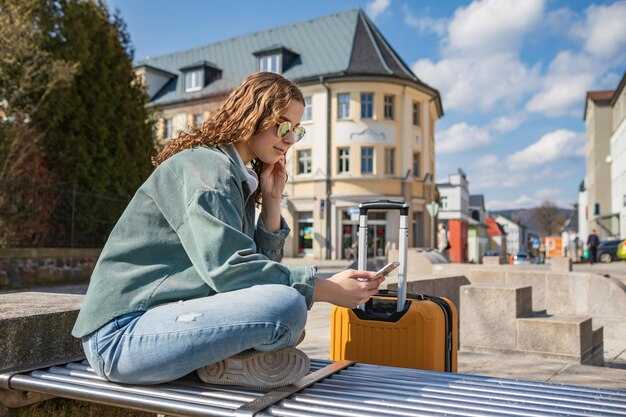Read this guide before you go to budapesht to save time and money. I recommend a clear plan: fokus on the central districts; clearly map a route with iconic views, and pack light to breeze through transit. If you have a regno for your accommodation, keep it handy and share it with the host to speed up check-in; also keep a simple note of your preferred districts for easy planning.
Smart choice: buy a transit pass for 24, 72, or 96 hours, depending on your itinerary. Compare prices, and read the metro map to pick routes that minimize transfers. The menu of options includes single-ride tickets and time-limited passes; use them to avoid waiting in lines. In crowded times, taxis can be pricey, so walking or cycling along the Danube riverbank offers an attractive balance of cost and experience. barely a few seconds can shift your next stop, so check live updates. also, the views from Buda hills are worth the climb.
For meals, focus on places with fresh fruit and seasonal dishes. Compare the menu ja price, because the same dish can have a different price depending on the block. Markets near the central stations offer reliable value and a sense of local life, while tourist eateries tend to be pricier. also try paprika chicken and gypsy sausage to experience familiar tastes in an authentic Budapest setting.
Bring a shared map with neighbors or fellow travelers to compare notes on activities and discounts. Budapest landmarks offer views, yet crowds peak in warm afternoons; plan morning visits to popular spots, or explore less known corners for a calmer experience. read local blogs and chat with staff to tailor tours that fit your interests, whether you focus on architecture, history, or urban views. For photographers, sunset from the central riverbanks provides a striking backdrop that boosts your tourism memories.
Best Time to Visit Budapest: Weather, Festivals, and Crowds

Plan to visit Budapest in late May or early September for the best balance of weather, crowds, and value. In May, daytime highs hover around 21–23°C, with cooler nights near 11–13°C and moderate rainfall of about 40–60 mm. September offers similar warmth (22–26°C) and comfortable evenings, with crowds easing after the peak. July and August bring the biggest crowds, especially along the Danube promenade and around major sites such as Parliament, Fisherman’s Bastion, and Heroes’ Square. To earn the most from your trips, order your days around nearby sites and images you want to see, focusing on two or three districts such as the Pest districts VII and VI, or the historic Belváros district, to balance popular sights with quieter corners.
Weather windows and crowd dynamics
Shoulder-season windows offer a milder feel and shorter queues. Shoulder-season windows offer temperatures around 20–24°C, occasional light rain, and plenty of outdoor cafes along the river. If you travel with kids or plan long days outdoors, plan most activity for late afternoon on breezy streets and bridges, where crowds thin a bit after work hours. Upon arrival, check transit options and ticket machines at metro stops, and use them to move around efficiently. Throughout your stay, mix indoor visits with long riverside walks to feel the city on both riverbanks and learn from the images you see on the sites around town. Later in the season, river cruises and markets shift to evening hours, offering cooler temps and lighter crowds.
Festivals, districts, and planning tips
Budapest hosts several events that shift crowds and prices. The Budapest Spring Festival runs in spring with concerts at major venues; Sziget Festival on Óbuda Island draws around half a million people in mid-August, affecting hotel availability and transport patterns–book months ahead if you plan to travel then. Christmas markets return late November through December, adding a festive atmosphere but crisper weather. In the regno of tourism, Budapest remains a popular stop for travelers; book accommodations in the VII or VI districts to stay close to action, or choose quieter pockets on the Pest or Buda banks for a calmer feel. If you want to see the biggest sites with fewer crowds, rather tailor plans to your interests: Parliament, the Danube promenade, and Buda Castle, then explore image-rich sites and talk with locals for learning about history and local customs. Soon you’ll have a practical plan that suits your interests, and you’ll earn memories for trips that stay with you long after you return.
Airport to City Center: Fastest and Budget-Friendly Options
Best option: order an uber ride for a direct door-to-door transfer to your hotel in the capital. A typical ride takes 25–35 minutes to central districts near the Danube and costs roughly 6,000–10,000 HUF, depending on traffic and surge pricing. This keeps your belongings safe and your travelling start smooth.
- uber ride or licensed taxi: Book via the app right after you land. The driver meets you at arrivals, helps with belongings, and drops you at your hotel on the most direct route. Pros: fastest option, comfortable, predictable stop. Cons: higher price and possible surge in busy periods.
- Public transport: The fastest budget route is the 100E bus from the terminal to Deák Ferenc tér, then a short walk or metro transfer to your hotel. Travel time about 40–60 minutes; single-ticket price around 900 HUF. Tickets are available at terminal machines or via official sites/apps. If you plan to explore, a day pass can offer better value while you stay near the Danube.
- private airport transfer or hotel shuttle: You can booking a private transfer through a hotel concierge or booking sites. Pickup is coordinated to your flight time, multilingual drivers, and a meet-and-greet in the arrivals area. Price ranges from roughly 15–25 EUR for budget options, with more for premium service.
Practical tips: always verify you’re using licensed services to follow the laws and protect yourself; still, it’s possible to compare options on reliable booking sites and choose the best fit for your budget and timing. If you travel with little or heavy belongings, a direct ride remains the natural choice to avoid extra handling. For thousands of travellers, this option delivers a smooth start to exploring the capital–especially around the Danube promenades. If you stayed at a hotel near the river, ask about their transfer offers; many hotels provide efficient, quality transfers or clear recommendations on the best pricing. Any arrival scenario can be made easier by planning ahead and keeping a flexible mindset for the first hours in the airport area, with any option you choose helping you get from airport to your destination quickly and comfortably.
Choosing a District: Buda vs Pest and Where to Stay
First pick Pest for a centralized base with easy transit, a wide range of eateries, and immediate access to nightlife. In inner Pest–Belváros-Lipótváros, Erzsébetváros, Terézváros–you’re within walking distance of Parliament, the Danube promenade, and a dense tram network. From Budapest Airport, use the 100E bus or rail link to Deák Ferenc tér; the ride takes about 30–40 minutes. A well-made schedule helps you cover big sights efficiently, giving you more options for day trips, restaurants, and quick connections to sights, with less time spent on transit.
In contrast, Buda suits travelers who want quieter mornings, green hills, and higher viewpoints. The Castle District and Buda Hills give you water views across the river and calmer streets. Bridges connect you to central sights in minutes, and you can add a hillside stroll or detour to nearby towns along the Danube, including Szentendre and Esztergom, for a different pace. This regno of hills and river towns offers a variety of day trips and photo ops. If you’re planning summer outings, the Buda side stays cooler and offers shady terraces and parks.
Where to stay depends on your rhythm and budget. If you crave a lively scene, choose Pest and focus on Deák Ferenc tér, the Parliament area, or Andrássy Avenue in Terézváros for a variety of cafés, shops, and quick transit using trams and metros. For space, greenery, and lower noise levels, pick Buda–ideally near the Castle or in Újbuda for more affordable apartments and easy access to hills and parks. dont miss family-friendly inns, modern studios, and boutique hotels that fit different budgets; each side has options made to suit different needs.
note: respect local laws about drinking in public and in licensed venues; always wearing comfortable shoes is advised for cobblestone streets and hills. dont forget to taste local fruit at markets, and try water or non-alcoholic drinks during hot days. Summer crowds are common, so booking ahead saves time and reduces stress. Avoid crowds at peak hours by planning around popular sights and using a mix of means–metro, tram, bus, and occasional taxi–to see more places beyond the city center.
Getting Around: Budapest Public Transport Passes and Ticketing
Get a 72-hour travel pass if you plan to ride 3+ times per day; it’s the simplest and good value for most visitors who focus on attractions between districts. It covers all metro, tram, and bus lines, so you can move from the front of the Parliament to the Danube banks without counting tickets every time.
For a shorter stay, a 24-hour pass or individual tickets can work, but run the numbers to see which option saves you time and problems. Typical days in Budapest mix sightseeing with dining and strolling, so having a pass that’s easy to use makes the entire schedule smoother and avoids back-and-forth bookings that eat up dates you’d rather spend on sights.
Where to buy: advance purchase is welcomed, and you can pick up passes at metro stations, at the official app, or at some kiosks near major entrances. If you’re staying near Franz Liszt Square, you’ll find convenient outlets on the east side and in quieter pockets where locals pick up tickets. Always check the front desk or a map for the closest booth, and keep your eyes on the screen for quick updates in English. Budapesht signage may differ between vendors, so compare two places if you’re unsure about the same product.
How to use: validate on entry to a vehicle; if you’re using the app, keep the digital ticket handy in case an inspector asks. If you happen to miss a validation, don’t panic–address it with a quick mind check by showing the digital pass on your phone. In most cases, the inspector will accept the last valid timestamp, especially for short trips between central sights. If you’re traveling with a group, note that some bookings can be linked to one user account but used by others on the same dates, which can simplify a shared plan.
To keep travel calm and avoid stress, plan one route per day and stay flexible for quieter evenings along the riverfront or around the dining districts near Andrássy Avenue. If you’re moving between the European quarter and the Buda hills, the main lines keep the drive short, and you’ll avoid the typical crowds on weekends. The system is straightforward once you get the hang of the validation steps, and you’ll quickly notice how easy it is to reach most sights with a single pass or a couple of quick hops.
| Pass type | Validity | Kattavuus | Where to buy | Paras | Muistiinpanot |
|---|---|---|---|---|---|
| Single ride ticket | One ride (renewable, if needed) | All metro, tram, and bus lines within city limits | Ticket machines, BKK official app, some kiosks | Short or one-off trips | Great for a quick hop; not cost-efficient for multiple moves in a day |
| 24-hour travel card | 1 day from first validation | All BKK lines | Metro stations, official app, select kiosks | Mid-length stays with several moves | Simple; consider if you’ll be out from morning to late evening |
| 72-hour travel card | 72 hours from first validation | All BKK lines | Metro stations, official app, select kiosks | 3 days of heavy sightseeing, Franz area and beyond | Often the best value for plans that include multiple sights and dining trips |
Money and Payments: When to Use Cash, Cards, and ATMs
Use cards for most purchases and keep a small cash stash for street stalls, markets, and transit tickets. Soon after you land, Budapest’s central districts show why locals go card-first, but many small vendors still prefer cash, and prices can feel inflated in tourist hotspots. Lets you handle each order with ease and makes it simple to manage their time and budget while packed with sightseeing. If your plane lands late, have cash ready so you can grab a quick bite without delays. Sadly, some outlets post cash-only signs after dark, so carrying a little money helps.
Käteinen: Milloin sitä kannattaa käyttää
Varaa 10 000–20 000 HUF päivässä pikkupurtavaa, torikojuja ja matkoja varten. Tämä kattaa pienet ostokset Suurkauppahallissa, paistetut välipalat Tonavan rantakadulla ja pari muhennosta rennoissa ruokapaikoissa. Keskustan rakennusten sisäänkäynneissä ja lähikaupoissa käteinen usein nopeuttaa jonoa. Älä koskaan luota vain yhteen maksutapaan; nopea lompakon tarkistus säästää aikaa, kun tarjoilijat kysyvät. Juuri sopiva määrä käteistä mahdollistaa pienten tilausten sujuvan maksamisen, erityisesti vilkkaina iltoina yöelämän alueella.
Kortit ja pankkiautomaatit: Miten maksat ja säästät

Visa ja Mastercard hyväksytään laajalti; Amex on harvinaisempi pienemmissä paikoissa. Käytä lähimaksuja ohittaaksesi jonot ruokapaikoissa ja valitse aina paikallinen valuutta (HUF) kehotettaessa, ja kieltäydy dynaamisesta valuutanmuunnoksesta välttääksesi korotetut hinnat. Nosta käteistä suurten pankkien (OTP Bank, K&H, UniCredit) automaateista saadaksesi paikallista valuuttaa ennustettavilla kuluilla. Tarkista kotipankkisi nostokulut ja päivittäinen raja ennen matkaa; tyypilliset kustannukset vaihtelevat nollasta muutamaan euroon per nosto sekä ulkomaanmaksukulu. Älä koskaan nosta enempää kuin tarvitset; jos rajasi on tiukka, jaa suuremmat ostokset kahdelle nostolle. Varo mainosbanneriita, jotka tarjoavat erikoishintoja – pysy pankkisi hinnoissa. Henkilökohtaisesti suosittelen säilyttämään kuitit, jotta voit laatia nopean budjetin matkan jälkeen ja jättää selkeän kuvan kulutuksesta. Jos syöt myöhään tai tutkit Budapestin yöelämää, lähellä oleva pankkiautomaatti auttaa sinua hoitamaan pienet kulut ilman, että sinun tarvitsee kiirehtiä takaisin hotelliin.
Kieli ja viestintä: Käytännön lauseita aloittelijoille
Aloita taskusanakirjalla tai offline-sovelluksella rakentaaksesi kansallista sanastoa ennen matkaa ja opi avainlauseita reittien kysymiseen, pyyntöjen esittämiseen ja maksujen hoitamiseen. Budapestissa henkilökunta ja paikalliset reagoivat paremmin, kun ilmaiset kiitollisuutta ja esität yksinkertaisen pyynnön muutamalla sanalla; jos sanaa ei löydy muististasi, käytä selkeää elettä ja vaihda englantiin, jonka tunnet useiden vaihtoehtojen joukosta.
Käytännöllisiä muistettavia lauseita
Ilmaise itseäsi lyhyillä lauseilla: ”Voisitko auttaa minua, ole hyvä?” ”Puhutko englantia?” ”Missä on lähin pysäkki?” ”Mikä on hinta kaupungin keskustaan?” ”Sisältyykö tämä hintaan?” ”Voisitko kirjoittaa sen?” ”Haluaisin kuitin, kiitos.” ”Hyväksyttekö kortteja?” Monissa maissa matkustavien kannattaa valita tavallinen vaihtoehto, jonka voi käyttää uudelleen. Pidä kopio tärkeimmistä tiedoista varastossasi, jotta et menetä sitä ruuhkaisissa paikoissa.
Huomioi kattavuus ja paikalliset tavat: Budapestin joukkoliikenne ja Tonavan jokiliikenne voivat muuttaa aikataulujaan vuodenajan mukaan; talvella päivänvalo on lyhyempi, mutta palvelu on edelleen luotettavaa. Tarkista aina tiedotuspisteet tai viralliset sovellukset saadaksesi päivityksiä. Jos myyjä ilmoittaa hinnan paikallisessa valuutassa, pyydä hinta kirjallisesti ja varmista, onko vero sisältyy hintaan. Pidä mukana seteleitä paikallisessa valuutassa ja muutama pieni seteli juomarahoja ja satunnaisia ostoksia varten. Jos eksyt, pysähdy ja pyydä apua henkilökunnan jäseneltä; sinut ohjataan oikeaan neuvontapisteeseen tai käännetään avainlause. Kun kysyt paikallisilta tunnetuista reiteistä, saat usein käytännön vinkkejä väkijoukkojen välttämiseen. Kävely Tonavan rantapromenadilla tarjoaa lisävarmuutta, kun kysyt ohjeita tai lepopaikkaa.
Ensin Budapest vai Budapesht: Kuinka paikalliset viittaavat kaupunkiin käytännössä
Käytä kaupungista puhuessasi aina nimeä Budapest, jotta sopeudut paikallisten seuraan. Budapesht esiintyy pääasiassa ulkopuolisten puheissa tai verkkomediassa; kun sanot Budapest, huomaat vastauksen olevan odotettua lämpimämpi ja luonnollisempi. Yöllä kadut hehkuvat vilkasta tunnelmaa, ja nimen ääntäminen oikein auttaa sinua luomaan yhteyden nopeammin. Jos joku sanoo Budapesht, älä korjaa ankarasti – hymyile vain ja vaihda takaisin Budapest-nimeen, jotta vuorovaikutus pysyy helposti ja kunnioittavana. Jätä positiivinen vaikutelma yksinkertaisimmalla muodolla, niin säästät myöhemmin aikaa näiden katujen tutkimiseen.
Käytännössä paikalliset käyttävät nimeä Budapest kylteissä, henkilökohtaisesti, varauksissa sekä ruokalistoissa ja ravintolakeskusteluissa. Jos etsit kaupungin ympäristön kohteita verkkosivustoilta tai arvosteluista, Budapest tuottaa odotetut tulokset; Budapesht putkahtaa esiin lähinnä kuriositeettina joissakin blogeissa tai mediassa. Suunnittele illanviettoon pálinkan maistelua ja rento ateria vilkkaalla rauniobaarialueella; huomaat, kuinka nopeasti henkilökunta vastaa, kun kysyt ohjeita tai paikkaa tutkittavaksi. Jos olet paikalla arkipäivinä tai kesällä, odota kimaltelevaa tunnelmaa täynnä olevine kahviloineen ja ruokakojuineen Tonavaa pitkin; yksinkertainen Budapestin käyttösi auttaa sinua sopeutumaan.
Ääntäminen ja yleinen käyttö
Paikalliset pitävät yleensä Budapestia vakionimenä; Budapesht tulee esiin lähinnä muiden kuin natiivien puheissa. Keskity lyhyeen, terävään painotukseen toisessa tavussa, ja kuulostat luontevalta. Huomioi unkarilaisten kaupunkien nimien perusäänteet välttääksesi ääntämisvirheitä, jotka hidastavat palvelua tai ohjeita. Jos opas sanoo Budapesht, vastaa Budapest ja siirry kaupungin tutkimussuunnitelmaan. Toivottavasti saat todellisen tunteen kaupungin energiasta.
Practical tips for travelers
Valitse matkan aikana luonnollinen tahti; valitse 2–3 kohdetta päivässä ja jätä sitten aikaa rentoutua illalla tai kahvilan terassilla. Kesällä kaupunki on täynnä; suunnittele viikolle välttääksesi väkijoukkoja, mutta viikonloppuisin on enemmän elävää musiikkia ja heijastuksia. Tarkista varaukset etukäteen, erityisesti suosituissa paikoissa; lue arvosteluja tunnistaaksesi joukon leipomoita, joissa on kakkuja ja leivonnaisia – kokeile kakkuja paikallisessa konditoriassa. Kun tilaat, katso ruokalistaa ja pyydä suosituksia; henkilökunta ehdottaa sekoituksen suolaisia ruokia ja kevyen jälkiruoan pääaterian jälkeen. Jos olet pidempään, tämä lähestymistapa auttaa sinua luomaan eeppisen päivän, joka sopii kaupungin tunnelmaan ylikuormittamatta aikatauluasi.



Kommentit